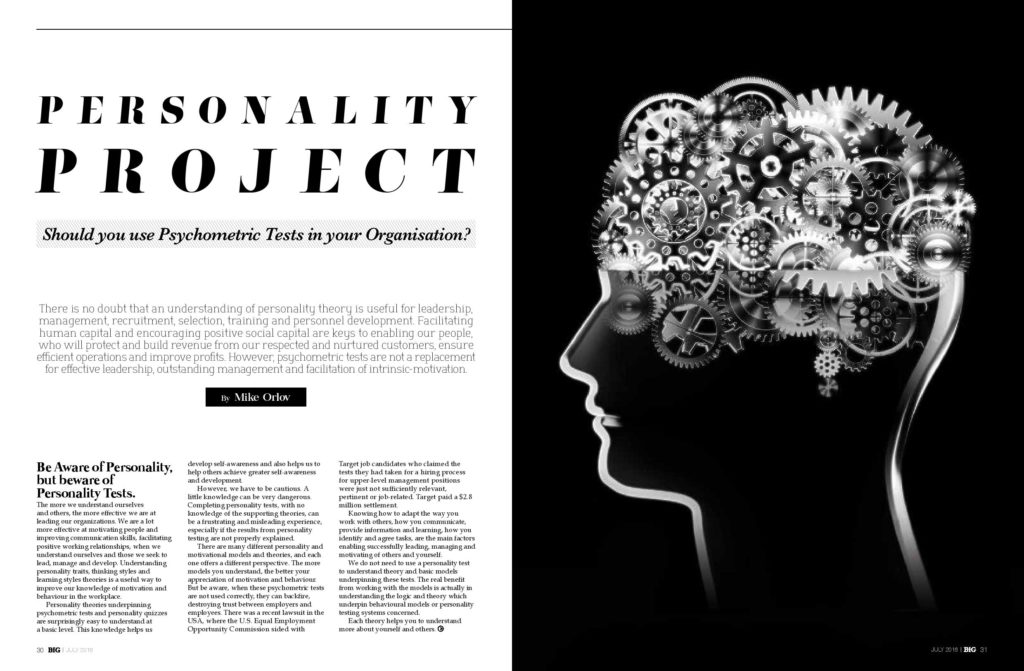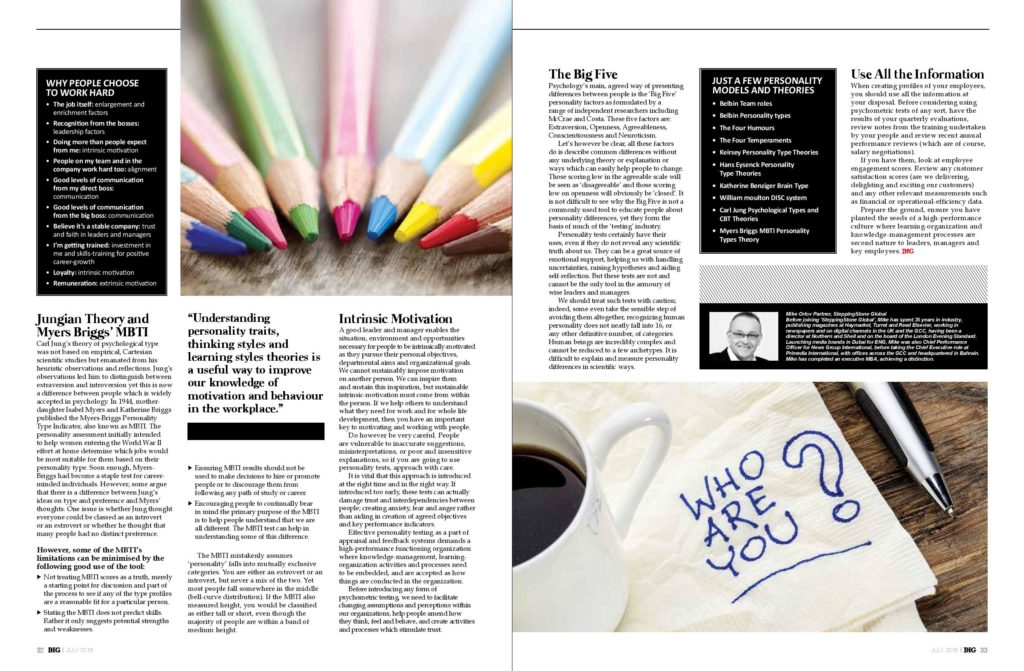

SHOULD I USE PERSONALITY TESTS IN MY ORGANIZATION?
Be aware of personality, but beware of personality tests.
Psychometric tests are not a replacement for effective leadership, outstanding management and facilitation of intrinsic-motivation.
There is no doubt an understanding of personality theory is useful for leadership, management, recruitment, selection, training and personnel development. Facilitating human capital and encouraging positive social capital are keys to enabling our people, who will protect and build revenue from our respected and nurtured customers, ensure efficient operations and improve profits.
The more we understand ourselves and others, the more effective we are at leading our organizations. We are a lot more effective at motivating people and improving communication skills, facilitating positive working relationships, when we understand ourselves and those we seek to lead, manage and develop. Understanding personality traits, thinking styles and learning styles theories is a useful way to improve our knowledge of motivation and behaviour in the workplace.
Personality theories underpinning psychometric tests and personality quizzes are surprisingly easy to understand at a basic level. This knowledge helps us develop self-awareness and also helps us to help others achieve greater self-awareness and development.
However we have to be cautious. A little knowledge can be very dangerous. Completing personality tests, with no knowledge of the supporting theories, can be a frustrating and misleading experience, especially if the results from personality testing are not properly explained.
There are many different personality and motivational models and theories, and each one offers a different perspective. The more models you understand, the better your appreciation of motivation and behaviour. But be aware, when these psychometric tests are not used correctly, they can backfire, destroying trust between employers and employees. There was a recent lawsuit in the USA, where the U.S. Equal Employment Opportunity Commission sided with Target job candidates who claimed the tests they had taken for a hiring process for upper-level management positions were just not sufficiently relevant, pertinent or job-related. Target paid a $2.8 million settlement.
Knowing how to adapt the way you work with others, how you communicate, provide information and learning, how you identify and agree tasks, are the main factors enabling successfully leading, managing and motivating of others and yourself.
We do not need to use a personality test to understand theory and basic models underpinning these tests. The real benefit from working with the models is actually in understanding the logic and theory which underpin behavioural models or personality testing systems concerned.
Each theory helps you to understand more about yourself and others.
A good leader and manager enables the situation, environment and opportunities necessary for people to be intrinsically-motivated as they pursue their personal objectives, departmental aims and organizational goals. We cannot sustainably impose motivation on another person. We can inspire them and sustain this inspiration, but sustainable intrinsic-motivation must come from within the person. If we help others to understand what they need for work and for whole life development, then you have an important key to motivating and working with people.
Do however be very careful. People are vulnerable to inaccurate suggestions, misinterpretations, or poor and insensitive explanations, so if you are going to use personality test, approach with care.
It is vital this approach is introduced at the right time and in the right way. If introduced too early without ensuring personality tests are seen as just a part of the overall, these tests can actually damage trust and interdependencies between people; creating anxiety, fear and anger rather than aiding in creation of agreed objectives and key performance indicators
Effective personality testing as a part of appraisal and feedback systems demands a high-performance functioning organization where knowledge-management, learning-organization activities and processes need to be embedded, and are accepted as how things are conducted in the organization.
Before introducing any form of psychometric testing, we need to facilitate changing assumptions and perceptions within our organizations, help people amend how they think, feel and behave, and create activities and processes which stimulate trust.
Human beings are incredibly complex and cannot be reduced to a few archetypes. It is difficult to explain and measure personality differences in scientific ways. Psychology’s main, agreed way of presenting differences between people is the ‘Big Five’ personality factors as formulated by a range of independent researchers including McCrae and Costa.
These five factors are: Extraversion, Openness, Agreeableness, Conscientiousness and Neuroticism.
Let’s however be clear, all these factors do is describe common differences without any underlying theory or explanation or ways which can easily help people to change. Those scoring low in the agreeable scale will be seen as ‘disagreeable’ and those scoring low on openness will obviously be ‘closed’. It is not difficult to see why the Big Five is not a commonly used tool to educate people about personality differences, yet they form the basis of much of the ‘testing’ industry.
Personality tests certainly have their uses, even if they do not reveal any scientific truth about us. They can be a great source of emotional support, helping us with handling uncertainties, raising hypotheses and aiding self-reflection. But these tests are not and cannot be the only tool in the armoury of wise leaders and managers.
We should treat such tests with caution; indeed, some even take the sensible step of avoiding them altogether, recognizing human personality does not neatly fall into 16, or any other definitive number, of categories. We are far more complex creatures than psychometric tests can ever reveal.
When creating profiles of your employees, you should use all the information at your disposal. Before considering using psychometric tests of any sort, have the results of your quarterly evaluations, review notes from the training undertaken by your people, review recent annual performance reviews (which are of course, are salary negotiations).
If you have them, look at employee engagement scores. Review any customer satisfaction scores (are we delivering, delighting and exciting our customers) and any other relevant measurements such as financial or operational-efficiency data.
Prepare the ground, ensure you have planted the seeds of a high-performance culture where learning-organization and knowledge-management processes are second nature to leaders, managers and key employees.
Why People Choose To Work Hard:
- The job itself: enlargement and enrichment factors
- Recognition from the bosses: leadership factors
- Doing more than people expect from me: intrinsic motivation
- People on my team and in the company work hard too: alignment
- Good levels of communication from my direct boss: communication
- Good levels of communication from the big boss: communication
- Believe it’s a stable company: trust and faith in leaders and managers
- I’m getting trained: investment in me and skills-training for positive career-growth
- Loyalty: intrinsic motivation
- Remuneration: extrinsic motivation
US Federal Human Capital Survey 2008
Just a few Personality Models and Theories
- Belbin Team roles
- Belbin Personality types
- The Four Humours
- The Four Temperaments
- Keirsey Personality Type Theories
- Hans Eysenck Personality Type Theories
- Katherime Benziger Brain Type
- William moulton DISC system
- Carl Jung Psychological Types and CBT Theories
- Myers Briggs MBTI Personality Types Theory
The following makes for a good box-out or column
Jungian Theory and Myers Briggs’ MBTI
Carl Jung’s theory of psychological type was not based on empirical, Cartesian scientific studies but emanated from his heuristic observations and reflections. Jung’s observations led him to distinguish between extraversion and introversion yet this is now a difference between people which is widely accepted in psychology.
In 1944, mother-daughter Isabel Myers and Katherine Briggs published the Myers-Briggs Personality Type Indicator, also known as MBTI. The personality assessment initially intended to help women entering the World War II effort at home determine which jobs would be most suitable for them based on their personality type. Soon enough, Myers-Briggs had become a staple test for career-minded individuals.
Isabel Briggs Myers (MBTI Psychometric Tests) explained in Gifts Differing how she built on Jung’s theories. However, some argue that there is a difference between Jung’s ideas on type and preference and Myers’ thoughts. A good summary of what this means is outlined in Dr Anna Maria Garden’s paper: ‘Unresolved Issues with The Myers-Briggs Type Indicator’. One issue is whether Jung thought everyone could be classed as an introvert or an extravert or whether he thought that many people had no distinct preference.
However, some of the MBTI’s limitations can be minimised by the following good use of the tool:
- Not treating MBTI scores as a truth, merely a starting point for discussion and part of the process to see if any of the type profiles are a reasonable fit for a particular person
- Stating the MBTI does not predict skills. Rather it only suggests potential strengths and weaknesses.
- Ensuring MBTI results should not be used to make decisions to hire or promote people or to discourage them from following any path of study or career
- Encouraging people to continually bear in mind the primary purpose of the MBTI is to help people understand that we are all different. The MBTI test can help in understanding some of this difference
The MBTI mistakenly assumes ‘personality’ falls into mutually exclusive categories. You are either an extrovert or an introvert, but never a mix of the two. Yet most people fall somewhere in the middle (bell-curve distribution). If the MBTI also measured height, you would be classified as either tall or short, even though the majority of people are within a band of medium height.
The consequence is that the scores of two people labelled ‘introvert’ and ‘extrovert’ may be almost exactly the same, but they could be placed into different categories since they fall on either side of an imaginary dividing line, without any scale of difference.
